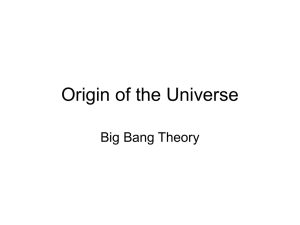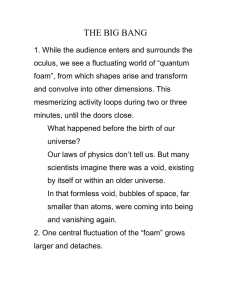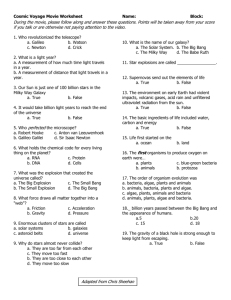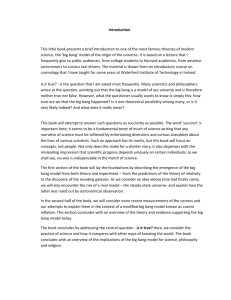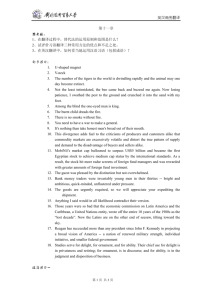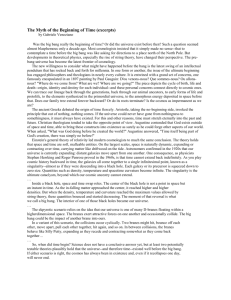Assessment language for COS page*
advertisement
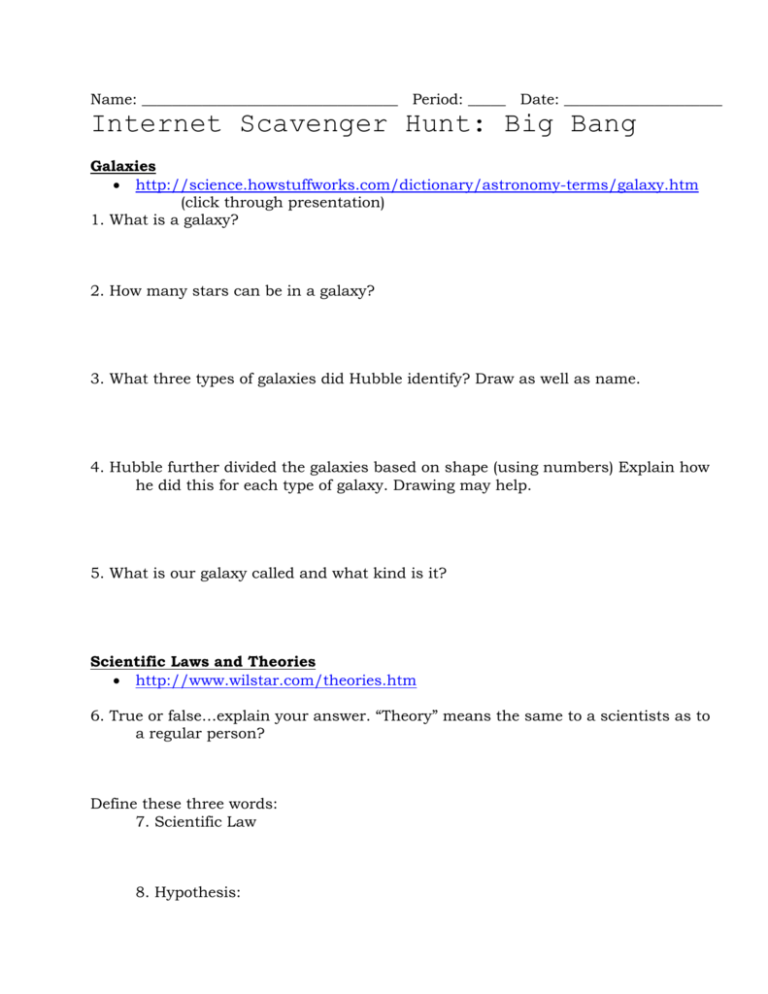
Name: __________________________________ Period: _____ Date: _____________________ Internet Scavenger Hunt: Big Bang Galaxies http://science.howstuffworks.com/dictionary/astronomy-terms/galaxy.htm (click through presentation) 1. What is a galaxy? 2. How many stars can be in a galaxy? 3. What three types of galaxies did Hubble identify? Draw as well as name. 4. Hubble further divided the galaxies based on shape (using numbers) Explain how he did this for each type of galaxy. Drawing may help. 5. What is our galaxy called and what kind is it? Scientific Laws and Theories http://www.wilstar.com/theories.htm 6. True or false…explain your answer. “Theory” means the same to a scientists as to a regular person? Define these three words: 7. Scientific Law 8. Hypothesis: 9. Scientific Theory 10. What do laws and theories have in common, in the scientific community? 11. What’s the biggest difference between a law and a theory in science? How the Big Bang Theory Developed http://www.timetoast.com/timelines/101764 (click on specific dots to see times and events in the development of the Big Bang theory) 12. What contributions did Albert Einstein make and when? 13. What contributions did Georges Lemaitre make and when? 14. What contributions did Edwin Hubble make and when? 15. What is CMB? When was it predicted? When was it discovered and by whom? 16. Who named the theory and when? 17. What are some more recent developments to BBT? The Big Bang Theory: http://www.umich.edu/~gs265/bigbang.htm http://www.pbs.org/wnet/hawking/universes/html/bang.html 18. About ______ billion years ago a tremendous explosion started the expansion of the universe. This explosion is known as the Big Bang. At the point of this event all of the matter and energy of space was contained ___________________________________. What existed prior to this event is completely _________________________ and is a matter of pure __________________. This occurrence was not a conventional explosion but rather an event filling all of space with all of the particles of the embryonic universe rushing away from each other. The Big Bang actually consisted of an explosion of ___________________________________________ unlike an explosion of a bomb were fragments are thrown outward. The galaxies were not all clumped together, but rather the Big Bang lay the foundations for the universe. 19. Who originated (came up with) this theory and based on what observations? 20. How did cosmic background radiation play a role in this theory? 21. What three reasons exist for believing in the Big-Bang theory? Timeline of the Big Bang: http://www.thirteen.org/hawking/universes/my_html/bigbang.html http://ssscott.tripod.com/BigBang.html if this doesn’t work, see version saved in SchoolPointe folder. 22. When everything was compressed into a small ball, what was the ball called? 23. What happened after 10-43 seconds? What was the temperature at this time? 24. What happened during the inflationary epoch? 25. What happened at three minutes? 26. What happened at 300,000 years after the Big Bang? (2 things) 27. When did galaxies begin to form? At what temperature? 28. What’s the temperature like today? Refinements to the Big Bang Theory: http://www.pbs.org/wnet/hawking/universes/html/fried.html 29. What is the Big Crunch? 30. What is the difference between a closed universe and an open universe? Different versions of the Big Bang: http://www.pbs.org/wnet/hawking/universes/html/osci.html 31. What is one implication of the Big-Bang theory? 32. How is an oscillating universe like an idea of a universe without end? http://archive.ncsa.uiuc.edu/Cyberia/Cosmos/CosmicMys teryTour.html Here is a diagram that shows that breaks the history of the universe into times and shows how big the universe was at that time. In the beginning 33. How did the name “Big Bang” get coined? 34. Was the Big Bang really an explosion? Explain. 35. What do we know about before 10 -43 seconds? 36. What happened to the temperature as the universe rapidly expanded? Quark soup 37. At 10-12 seconds, the four forces finished separating. Gravity is one of those forces. What are the other three? 38. The universe acts like there’s more matter out there we can’t see. It’s called dark matter. What source might there be from this time for dark matter? Big Freeze Out 39. What is the “Era of Nucleosynthesis?” What happened, when was it and how long did it last? 40. Where did the other elements we know of come from? Parting Company 41. During this time, pieces of atoms (protons and atomic nuclei) were bounced around by light (photons). How long did this last? 42. At the end of this recombination, the temperature had dropped to 3000K and left a “signature.” What is that signature? Galaxy Birth 43. How did galaxies form and when were the first ones born? 44. What is a quasar and why are they useful? Today’s Universe 45. What are some limitations (unanswered questions) of the Big Bang Theory? Other sites: Foundations of the theory, observational tests and limitations: http://map.gsfc.nasa.gov/m_uni.html Proof: http://www.damtp.cam.ac.uk/user/gr/public/bb_pillars.html Unanswered questions: http://www.damtp.cam.ac.uk/user/gr/public/bb_problems.html pretty simple…good picture…then goes into too many piddly scientists…then to steady state, Penz & Wils, COBE, DIRBE http://ssscott.tripod.com/BigBang.html these are particularly good…look at for next year… Not bad…pretty simple. http://cosmology.berkeley.edu/Education/IUP/Big_Bang_Primer.html Step by step (kind of technical…lead them through it): http://archive.ncsa.uiuc.edu/Cyberia/Cosmos/CosmicMysteryTour.html and some about theories and laws… http://www.carlton.srsd119.ca/chemical/Proof/default.htm http://www.wilstar.com/theories.htm http://chandra.harvard.edu/chronicle/0708/theo/ evolution, specifically…. http://www.evolution.mbdojo.com/theory.html http://www.notjustatheory.com/
